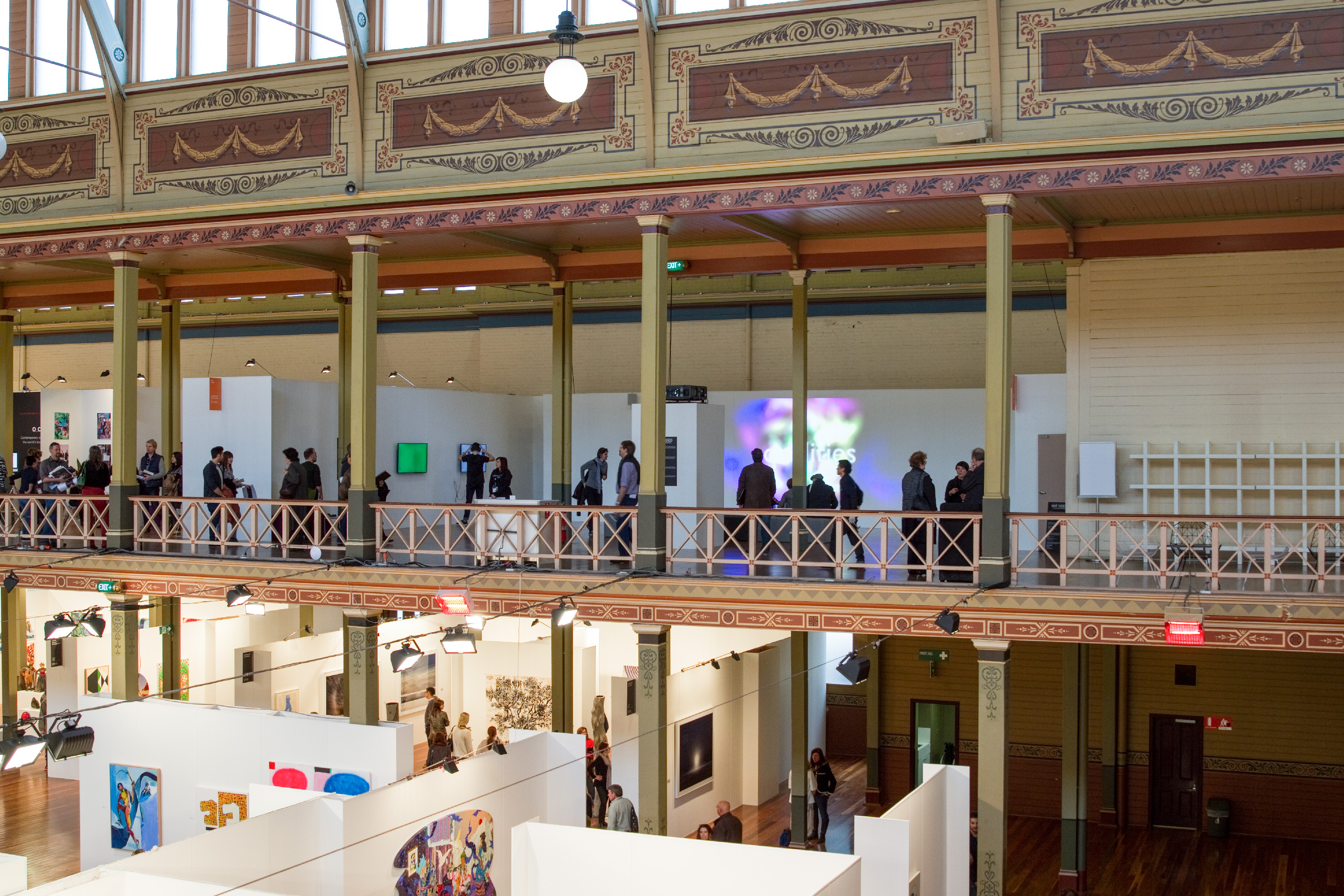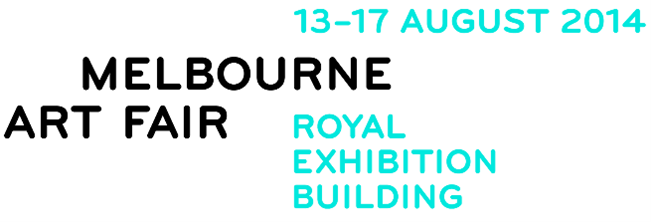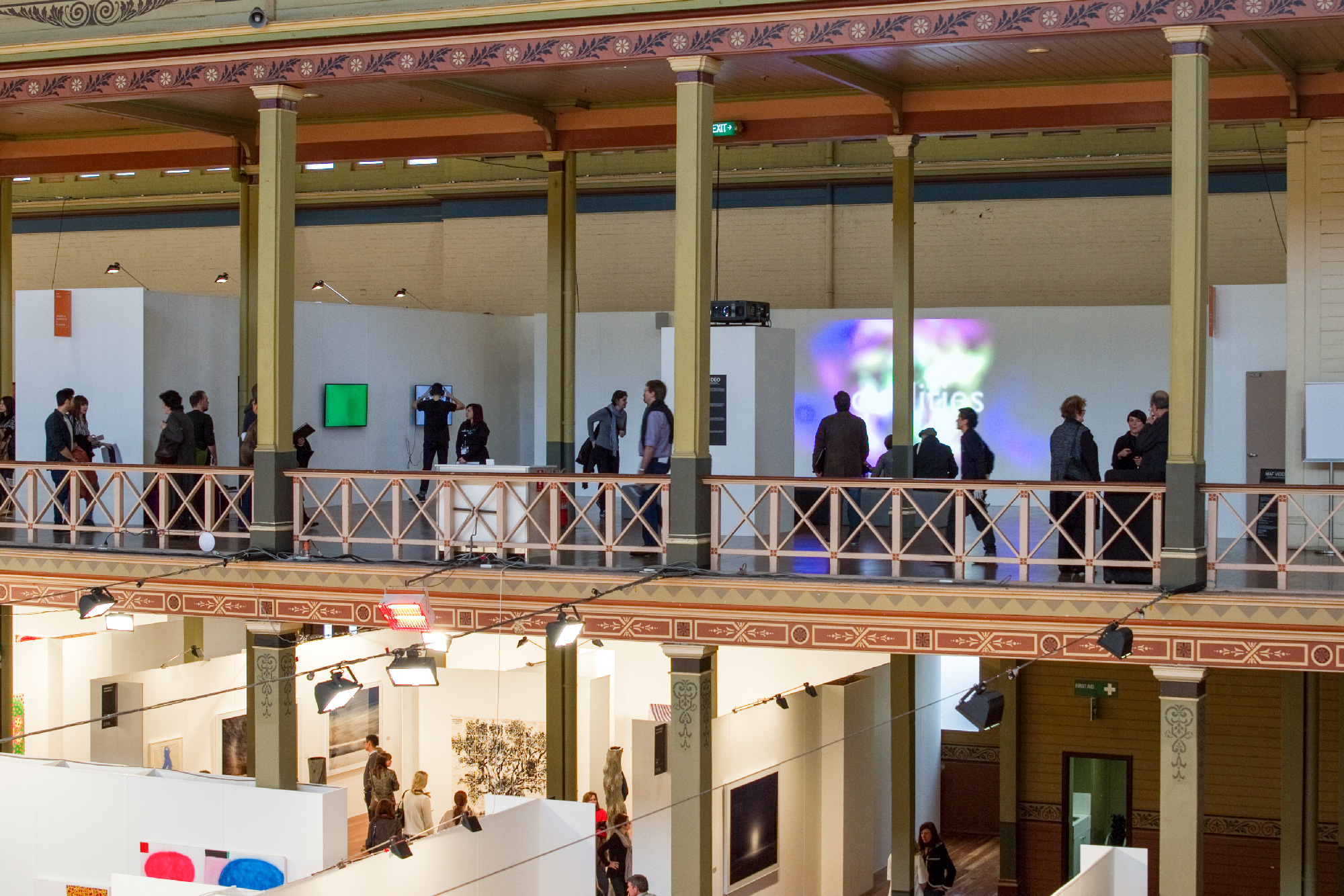
MAF Video, 2014. Melbourne Art Fair, Royal Exhibition Building, Melbourne. Installation View.
MAF Video
Peter Alwast, Joshua Bonnetta, Nicole Breedon, Eric Bridgeman, Lauren Brincat, Barbara Cleveland, Peter Daverington, Sue Dodd, Hamishi Farah, Hayden Fowler, Nathan Gray, Joe Hamilton, Sonia Leber and David Chesworth, Rowan McNaught, Archie Moore, Scott Morrison, David Mutch, Baden Pailthorpe, Jacqui Shelton, Grant Stevens, Angela Tiatia, Marian Tubbs, Kawita Vatanajyankur, Tim Woodward
Curated by Simone Hine and Kyle Weise
Melbourne Art Fair, 13-17 August, 2014
The 2014 Melbourne Art Fair video program (MAF Video) presented four themed exhibitions of single-channel video work, presented over the four days of the art fair. Across two projectors and four monitors, each theme offered a glimpse into contemporary video practice, a microcosm of the strength and diversity of contemporary Australian video art.
Additionally, selections of the program were exhibited on the Federation Square big screen and in Higson Lane, both in the Melbourne CBD.
The program included artists represented by galleries exhibiting at the fair, as well as a selection of unrepresented artists, and was accompanied by text for each program and work, written by Simone Hine and Kyle Weise.
See below for texts for each of the themed exhibitions, a full list of works and selected press on the project.
Staging Actions
Quotidian Rhythms
Synthetic Landscapes
Circuits of Consumption
Staging Actions
Staging Actions presents performance work that has been made for video. Here, video does not act as documentation of a live performance that constitutes that artwork ‘proper’, but rather is an active component in the construction of the performance, and an integral part of the work. The characteristics of video allow the construction of the performances. For a generation whose exposure to the seminal performance art of the 1970s has been mediated through video, it is unsurprising that, for many contemporary artists, video and performance are entangled and inseparable from one another.
Sue Dodd’s Wendy Airhole is an ode to both costume and performance. Played sequentially here, the videos scroll through a series of personas and musical genres. Shot in black and white and performed by the artist, this work draws a clear lineage from the Untitled Film Stills of Cindy Sherman. However, Dodd focuses her attention on popular music genres, rather than cinema. Through the careful combination of makeshift costuming and precise song-writing and performance, Wendy Airhole shines a light on the highly constructed way in which popular music is produced and presented, while at the same time reminding us of the connections to personal memory embedded within the diverse genres presented.
Kawita Vatanajyankur’s ongoing video series Tools, presents individual performances that test the limits of the artist’s body. Drawing on the history of feminine representations in Western painting, Vatanajyankur attempts to turn her body into the tools of domestic labour that have, historically, defined these representations. The Ice Shaver is unique in this series of video performances because it takes the ice shaver, a common tool to make ice drinks in Thailand, where the artist lives and works, as its subject. Isolated within the confines of the video frame like a moving still-picture, the bright high-definition image draws one into the seductive allure of the work, while knowledge of the corporeal reality of each action functions to repel. This disjuncture reflects a dichotomy at the heart of feminine representation, creating an unease aimed at disrupting traditional representations of female labour.
Barbara Cleveland's This is Barbara Cleveland replicates the format of a documentary; within this it also replicates the genre of performance art as a series of documentary stills, in order to create a portrait of a fictional character: 1970s performance artist Barbara Cleveland. In a gesture that references Rodney Graham’s work from 2006 Lobbing Potatoes at a Gong (1969), in which the artist appears as a fictional performance artist, This is Barbara Cleveland similarly questions the originality of the artist, demonstrating the way that art practices can be replicated and condensed into a series of key gestures. Like Graham, Barbara Cleveland use humour to consider the obscurantism and mythologising tendencies of contemporary art.
Angela Tiatia's Hibiscus Rosa Sinensis starts with the camera drifting over lush foliage until the camera fixes on the close up of the artist’s face, which seems to emerge out of the landscape. The image created appears as an idealised image of a Pacific woman, with the exception of the Hibiscus held in the mouth, instead of being worn as a form of adornment. Staring into the camera with quiet defiance, Tiatia slowly ingests this iconic flower, symbolically synthesising culture and self, while critiquing dominant representations of the Pacific.
Lauren Brincat’s Steady as She Goes utilises the frame of the video to create a moving still image. The soft mist and lush landscape create an aestheticized scene. The single action of the artist walking through the landscape, and disappearing into the distance, invites the viewer to watch with a pensive gaze, as this simple gesture plays out with a sense of the inevitable. Steady As She Goes evokes Richard Long’s seminal 1967 work A Line Made by Walking, in which the artist merged two dominant artistic movements, Performance Art and Land Art, by presenting the remnants of a performance as a mark upon the landscape. Long’s work, a trampled path made by the artist as an imprint on the landscape, contains both time and the gesture. Steady as She Goes utilises video, as a documentary medium, in order to capture a fleeting action through a lasting visual record.
In the Project documents the studio activities of Eric Bridgeman while on a three month residency in Alberta, Canada. Isolated in a small town, some two hours drive from the University that was hosting the residency, In the Project presents a portrait of a solitary man alone in an unfamiliar location. Bridgeman states, “I brought along a Golliwog doll I had saved from a boutique teddy bear store in Melbourne in 2010. I didn’t know it at the time, but the Golliwog would come to serve as my only solid companion throughout my project in the mountains.” Despite receiving regular updates from his home in Papua New Guinea, the reality of Bridgeman’s experience over those months was an isolating one. The video appears to give us intimate insight into the artist’s time in Canada, showing private moments; while the fluidity of the exposition offers an emotive impression, rather than documentation of this time. Via this video portrait, the process of making is explored, and the construction of both art and identity are entangled.
Top of Page
Quotidian Rhythms
Quotidian Rhythms presents videos in which the artist, often a visible or implied performer in the work, uses basic materials to explore the literal or metaphorical rhythms of everyday life. The works linger, in inventive ways, on the objects and spaces that surround us; drawing us into their rhythms. Some of the works instil an almost meditative gaze through repetition and looping, while in others the rhythms are more jarring, and play with the unexpected activations of the everyday, via actions and editing.
Nicole Breedon's B-B-Brooklyn isolates a single aspect of the urban environment, a basketball being thrown at a hoop, and repeats it again and again. These iconic locations are not only integral to the landscape of Brooklyn, but to our cultural references to the city of New York. Without seeing the entire location, it is easily extrapolated, because the courts that are scattered around the city are so familiar to our notion of New York. This gesture not only highlights the audio rhythms that surround us in the urban environment, but shows the way the same gestures are repeated by different people in different locations. It is these repeated gestures of people in their everyday life that forms the rhythm of the city. A melancholic element is added by the repeated failure of the ball to pass through the hoop, reflecting the Australian artist’s longing for home.
Tim Woodward's A Film is Cut to the Swing of a Clock was made while on a residency at the Cité Internationale des Arts, Paris. Woodward bought a clock in his first week in Paris. It was a homemade pendulum clock with a face in the shape of a painter’s pallet. Placed on the wall of his studio in this prestigious institution, it acted as a personal amusement, referencing the traditions of art and the artist. However, over the course of the residency, the constant sound of the pendulum marking time began to act as a metronome for his work, guiding the editing process of works made within its proximity.
The marking of time is a constant element within life, but this is perhaps most relevant when one marks the time spent working. The historical development of the clock, and the development of labour, as we understand it, are deeply intertwined. This is replicated in the subject of the video, which depicts a man cleaning a water feature with a broom. Each sweeping motion creates a rhythm that organically marks time. In this way, A Film is Cut to the Swing of a Clock brings together two sets of time: one marked by a mechanical clock, and the other marked by a gesture. By arbitrarily breaking the sweeping action according to mechanical time, the work seems to attempt to order the otherwise organic rhythm set by the worker. Furthermore, the combination of action and edit brings together two types of labour: manual and artistic. Placed side by side, we are left to wonder about the value of both. The marking of time creates several layers within this work, which is perhaps due to the omnipresence of time ticking, sitting in the back of the mind, only coming to focus when we choose to disrupt its rhythm by focusing upon it.
Jacqui Shelton's Silt/Suspended Load occupies a space between performance, photography and moving image. In a simple gesture that is repeated ad infinitum, the artist is seen hanging underneath a ladder that is tilted against the side of a building in an unremarkable lane. Subtle and precise editing produces a rhythm that is only possible within the context of a moving image. The repetitive pendulum motion creates a consistent rhythm that produces a stillness within the work, replicating photography as a medium designed to capture a moment and suspend time.
A fluorescent light flickers as it powers on to illuminate. In Fluorescent Composition III, David Mutch takes this inadvertent stuttering and, via elaborate video editing, pushes this to its rhythmic extremes. The effect of the resulting, endlessly looped video, is both hypnotic and frustrating. Referencing the history of artistic experimentation with fluorescent tubes, as in the work of Dan Flavin and Bruce Nauman, amongst others, Mutch appropriates this iconic object only to de-materialise it, both metaphorically and literally. Flattened into a perspective-less image, never allowed to illuminate for more than a second, the fluorescent tube, as object, escapes our grasp: abstracted to light and line. Fluorescent light, concrete, plastic raincoats: these are recurring themes across Mutch’s practice as it spans video, installation, photography and sculpture. Together, these material tropes present a cold, brutal and, at times, apocalyptic landscape. Fluorescent Composition III continues in this bleak trajectory, using the visual rhyme between lights and screens to gesture towards both the abstraction and failure of technology.
Nathan Gray’s ever accumulating Works: Under 30 Seconds, of which No.2 is presented here, is a series of very short video vignettes which use basic materials (a ball, a bag, a balloon, a hoodie, and so on) to construct ultra-brief visual gags. Taking inspiration from Erwin Wurm’s ongoing One Minute Sculptures, Gray’s works similarly subvert expectations and make surprising use of materials and bodies. In compressing the time of Wurm’s work by half, the series reflects on our contemporary context: obsessed with velocity, speed and instantaneity. Gray’s parallel practice as a musician is often hinted at in the series, but any expected percussive development, as found in Gray’s 5-channel video Species of Spaces (2014) for example, is truncated: a drumstick becomes flaccid before it can be used, a box of pipes is emptied on to the floor, a ping-pong ball bounces and breaks. The rhythmic possibilities of the everyday are hinted at and briefly activated, only to quickly disappear, escaping our grasp.
Filmed in the now-vacant and soon to be demolished former headquarters of The Age newspaper in Spencer St, Sonia Leber's and David Chesworth's We are Printers Too, uses percussion instruments to recall the industrial machinic rhythms of the traditional printing press. In the past decade, Fairfax Media, the owners of The Age, have developed and then closed another printing press in Tullamarine, reflecting the continued decline in demand for printed media and the rise of alternative modes of production and consumption. The echo of the instruments through the vacant building, in the work, harkens to both the legacy of industrialisation in determining the rhythms of our working lives, while also pointing towards the modulation of this in the context of post-industrialisation.
Top of Page
Synthetic Landscapes
Synthetic Landscapes includes a diverse range of works, all linked via their construction of landscapes, through elaborate editing, set design, computer generated imagery, or a combination of these processes. Here, the window onto the landscape, so central to Western art, finds itself complicated and compromised through a mass of mediations, illusions, and interruptions. These disruptions are enabled by screens, a technology whose fractured modes of looking are increasingly merging with, and also replacing, the function of architectural windows.
Peter Daverington's Arcadia begins with a black screen. Slowly a line is drawn marking two-dimensional space, this line extends to form a three-dimensional grid, which builds to create a set of graphic stairs. The frame of the video ascends along the path of the stairs into a mimetic landscape that appears to float above this representation of digital space. Reminiscent of fantasy art, the mimetic environment references painting as the medium of its construction, however, as a three-dimensional digital space, it also references the virtual environments of video games. As the viewer floats above the virtual landscape, graphic objects float past, creating a disjuncture between mimesis and the forms used to construct it. The synthetic landscape is seen here to be a palimpsest of virtual space.
Joe Hamilton’s Stream appears almost as an animated version of a google image search for the term ‘stream.’ Here, the fluidity of data flows is semantically rhymed with that of water flows, as we are presented with cascading, layered and constantly moving images of water streams: a data ‘stream’ of streams. Occasional images of glaciers melting into liquid streams remind us of global warming and the ultimate environmental effect of the technologies that produce the virtual streams of data in which we are immersed.
Hayden Fowler’s New World Order presents a bleak synthetic landscape. Naked branches twist in the foreground and a painted backdrop extends the illusory space beyond the constructed set in which the work was filmed. This highly constructed environment is occupied by a group of chickens. As a speciality breed of chicken, the physical form of these birds is the product of generations of careful rearing. This combination of a constructed landscape with a selection of elaborately cultivated living forms, moves us to a question at the heart of New World Order: where do synthetic and natural landscapes begin and end?
For over one hundred years cinema has created worlds and allowed us to occupy them virtually for fragments of time. Our recollections of cinema, however, move beyond the time spent watching a film to permeate perceptions of the world beyond the cinema. Joshua Bonnetta’s Lanterna works to explore the way particular landscapes have been transformed by cinema. By evoking the iconic films of Ingmar Bergman, specifically a series of six films photographed on the small Swedish island of Fårö between 1957 and 1979, Bonnetta weaves together non-linear narratives that extend the landscapes created by Bergman. Returning to the island, Bonnetta utilises Bergman’s aesthetic in order to present a view of the contemporary landscape as necessarily understood in terms of its historically significant cinematic portrayal.
Scott Morrison's small choir moves from simple edits that fade into one another, creating a formal relationship between the detailed foreground and an out-of-focus middle ground, to increasingly complex edits, which use sound and rhythm, to create a landscape that sits within the realm of temporal experience, rather than the physical landscape from which the imagery is derived. Morrison uses representational footage of a familiar world of natural elements, however, the undulating rhythms created through the editing process, in-camera panning and focus-shifting, work to bend perceptions of spatial density and time, creating a landscape that is at once familiar and unfamiliar. small choir focuses attention towards the effects produced by the camera lens and the role of the camera in constructing landscape.
Baden Pailthorpe’s digital animation, MQ-9 Reaper I, presents a computer animated landscape occupied by technologies of war. Initially developed for military applications, the ongoing evolution of computer graphics and virtual environments is now produced via feedback loops between the military and the entertainment industry. The technologies of videogames, for example, have developed in parallel with the technologies used by remote pilots to control military drones. Central to Pailthorpe’s animation, which, visually, brings to mind both contemporary videogames and Google Earth, are two versions of the MQ-9, a United States Air Force drone. As the two drones slowly contemplate each other, the machines seem to have more life than the human character in the work, gesturing towards the increasing autonomy of these technologies: patrolling, scanning and, potentially, destroying the landscape below them. Technologies of computer animation are complicit in this militarisation of the landscape, yet also provide representational strategies through which these can be critiqued and interrogated, as Pailthorpe’s work demonstrates.
Top of Page
Circuits of Consumption
Circuits of Consumption takes us on a journey through the landscapes and networks of contemporary consumption. The works traverse from logo-filled cityscapes, to analyses of virtual finance, through to dizzying collage-like assemblages. Together, the videos investigate the role of capitalism in the formation of both our identity and the spaces around us.
Archie Moore's Kinelexic Tokyo documents a journey through Tokyo, recorded by Archie Moore from the window of a taxi. In this journey Moore attempted to retrace the path of a car presented in the 1972 Andrei Tarkovsky film Solaris. This was a journey without destination and, similarly, Kinelexic Tokyo depicts a landscape rather than a destination. Once the footage was shot, Moore reduced the video to its individual frames. From here he started the arduous task of digitally over-painting everything in the image with a vibrant green paint, except the signage on shop fronts and billboards. The masked image gives a particular view of the city. The signage floats across the screen isolated by a green glow reminiscent of the ‘green screen’ used in the construction of cinematic special-effects. Here, the landscape is given over to the sea of advertising images that define our experience of the city.
Hamishi Farah's Self Titled compiles a range of short videos, which together present a disjunctive stream of images, objects, icons and text. The only consistent element, a stark white background, connects the work to the space of the contemporary art gallery. Against these white 'walls';, Farah assembles before us a rumination on a world broken into logos, snippets and sound bites. A generic, automated voice-over delivers a stream of tweets, taken from both Farah's own Twitter account as well as from tweets culled from others around the globe. Re-contextualised here, these spoken tweets move swiftly from amusing to disturbing to melancholic, and present a world in which personal identity and brand-identity have become increasingly intertwined. Not only is this a world in which the products we consume construct, in part, our sense of self, but also one in which we increasingly communicate in the short, sharp bites typical of advertising. Just as corporations use websites, Facebook and Twitter to build their 'brand identity', so we, as consumers, use these same platforms to construct our personal identity. Unified through the singular voice-over of Self Titled, any quest for individuality within this seems doomed to the homogeneity of the corporate internet.
In Grant Steven's Auric Variations, A calm steady voice reads a series of dislocated words, as colours morph into one another in a blur of Photoshop filters. The combination of positive statements, atmospheric soundscape and soft fades act to create a sense of manufactured well-being that is countered by the occasional slightly negative statement, which remains partially obscured by the general effect of the work. Reminiscent of the language used in self-help books, Auric Variations speaks of the conditions of contemporary consumer culture, whereby products and lifestyles become inseparable and are sold on promises of happiness.
Rowan McNaught’s Wild Pointer presents an image of an open car boot, and was originally exhibited on a monitor within the car boot represented. As part of Das Boot, an artist-led interpretation of a car boot sale, organised as part of the 2014 Next Wave festival, Wild Pointer contrasted the physical stationary car, in which it was housed, with the incessant movement of its virtual, screened iteration. American writer Anne Friedberg asserts the centrality of the car windscreen in the expansion and acceptance of the mobile gaze, as the view through the windscreen became an increasingly common perspective on the world. From the normalisation of the car windscreen as a mode of vision, it has been a swift movement to the acceptance of the virtual mobile gaze of the electronic screen. In this context, as in the transformation of car into screen in Wild Pointer, the linearity and implicit narrative of the car journey is replaced by the unpredictability of the hyperlink. As such, Wild Pointer moves us rapidly between locations, and temporal sequence is subsumed by the spatial layering of video, drawing, graphics and text. Travel is a recurring theme in the work: the iconography of airport signs and passport gates appears, while the voiceover speaks of planes and airports. Physical and screen journeys are collapsed in Wild Pointer, as they are for the all-consuming gaze of the so-called global citizen: the First world elite who move rapidly across the globe via screens and airports. Movement becomes the ultimate act of consumption, as the Earth is consumed visually, as a set of interchangeable surfaces, and physically, via the rapid depletion of resources that sustain our obsession with velocity and momentum.
In Marian Tubb's Vulgar Latin, gold coins, lightning, snake skin silk, rudimentary graphics, diamonds, pixels and the ruins of a Greek resort are juxtaposed in a moving digital collage. They are images that present themselves as such. They are hollow surfaces floating without context, cutting across each other like pieces of paper moving through digital space. Connections are implied by the temporal proximity of these images to each other, but the connections are fleeting as the images move without pause. Images of wealth, presented as digital icons, and decay, presented as photographic evidence, create the impression of a social and economic order that is not as prosperous as advertised. These impressions are produced via simple juxtapositions that invite the viewer to draw their own connections. Vulgar Latin presents a bleak impression of the world, post-financial crisis, which sees the fate of bricks and mortar tied to a world of hollow digital imagery.
Peter Alwast's Light Study explores abstraction: as aesthetic, as economic construction, and as ontology. One half of the screen presents an abstract, glowing digital animation of pipelines, through which the work constructs a visualisation of global communication networks as sleek and weightless. The beauty of this overtly idealised vision reflects the way that these networks have become intertwined with, and co-opted by, the seductive promises of finance capital and the ever-expanding, and often dizzying, range of global financial instruments that sustain it. This is what American critic Fredric Jameson refers to as 'hyperspace': a financial world made possible by information travelling (almost) at the speed of light. This context leaves us incapable of mapping the complexity of the global networks in which we are caught, and in which the financial structures that affect our daily life are increasingly abstracted from our everyday experience. It is this ordinary experience that Alwast juxtaposes, dramatically, against his alluring animations. Here, in the other half of the screen, a series of simple still video sequences present a melancholic portrait of an ordinary suburban environment, in which the repercussions of the global-financial crisis linger: an unfinished and abandoned office complex, the nervous tapping of a foot. The voice-over accompanying the video makes these connections explicit, but the hard line that separates the work's two halves, via a split-screen, remains firm and their reconciliation elusive.
Top of Page
Text by Simone Hine and Kyle Weise
[pdf version here]
List of Works
Sue Dodd, Wendy Airhole video series, 2013. HD Video. Sound. Selection of 7 of 8 videos, various lengths. Represented by Anna Pappas Gallery.
Barbara Cleveland, This is Barbara Cleveland, 2013. Single-channel HD Video. Sound. 16min 42sec. Written & Directed by Barbara Cleveland. Original Score by Lucy Phelan. Sound & Video by Elliot Hughes. Represented by Sullivan + Strumpf.
Angela Tiatia, Hibiscus Rosa Sinensis, 2010. HD Video. Sound. 1min 30 sec. Alcaston Gallery
Lauren Brincat, Steady As She Goes, 2011. Documentation of an action. Single-channel HD Video. Sound. 2min 40sec. Represented by Anna Schwartz Gallery.
Eric Bridgeman, In the Project, 2012. Single-channel SD video. Sound. 5min 46sec. Represented by Gallerysmith.
Nicole Breedon, B-B-Brooklyn, 2013. HD Video. 2 min 36 sec.
Tim Woodward, A Film is Cut to the Swing of a Clock, 2014. SD Video. Sound. 3 min 3 sec.
Jacqui Shelton, Silt/Suspended Load. HD Video. Loop.
David Mutch, Fluorescent Composition III, 2013. HD Video. Sound. Loop.
Nathan Gray, Works: Under 30 Seconds No.2, 2014. HD video. Sound. 15 sec.
Sonia Leber and David Chesworth, We Are Printers Too, 2013. HD video. Sound. 16 mins.
Peter Daverington, Arcadia, 2012, HD Video. Sound. 8 mins 54 sec (loop). Represented by ARC ONE Gallery
Joe Hamilton, Stream, HD Video. Sound. 1 min 20 sec (loop). Represented by blackartprojects
Hayden Fowler, New World Order, 2013. HD Video. Sound. 15 mins 17 sec. Represented by Artereal Gallery
Scott Morrison, small choir, 2012. HD Video. Sound. 9 mins (loop).
Joshua Bonnetta, Lanterna, 2014. HD Video. Sound. 35 mins.
Baden Pailthorpe, MQ-9 Reaper I, 2014. HD 3D animation. Sound. 4 mins 39 sec.
Archie Moore, Kinelexic Tokyo, 2012. HD Video. Represented by The Commercial
Hamishi Farah, Self Titled, 2014. HD Video. Sound.
Grant Stevens, Auric Variations, 2012. HD Video. Sound. 5mins 7sec. Represented by Starkwhite
Rowan McNaught, Wild Pointer, 2014. HD Video. Sound. 9mins 3 sec.
Marian Tubbs, Vulgar Latin, 2014. HD Video. Sound. 5min 39 sec.
Peter Alwast, Light Study, 2013. Dual-channel HD Video. Sound. 6mins 35sec. Represented by Gallery 9
Selected Press
Chloe Wolifson. "Melbourne Art Fair, Spring 1883, & NotFair, 2014." Chloé Wolifson. 21 August, 2014. Online. pdf.
Lucy Stranger, "2014 Melbourne Art Fair" Artist Profile 2014. Online.
Jane O'Neill. "City of Art" Emirates Inflight Magazine, August, 2014. pdf.
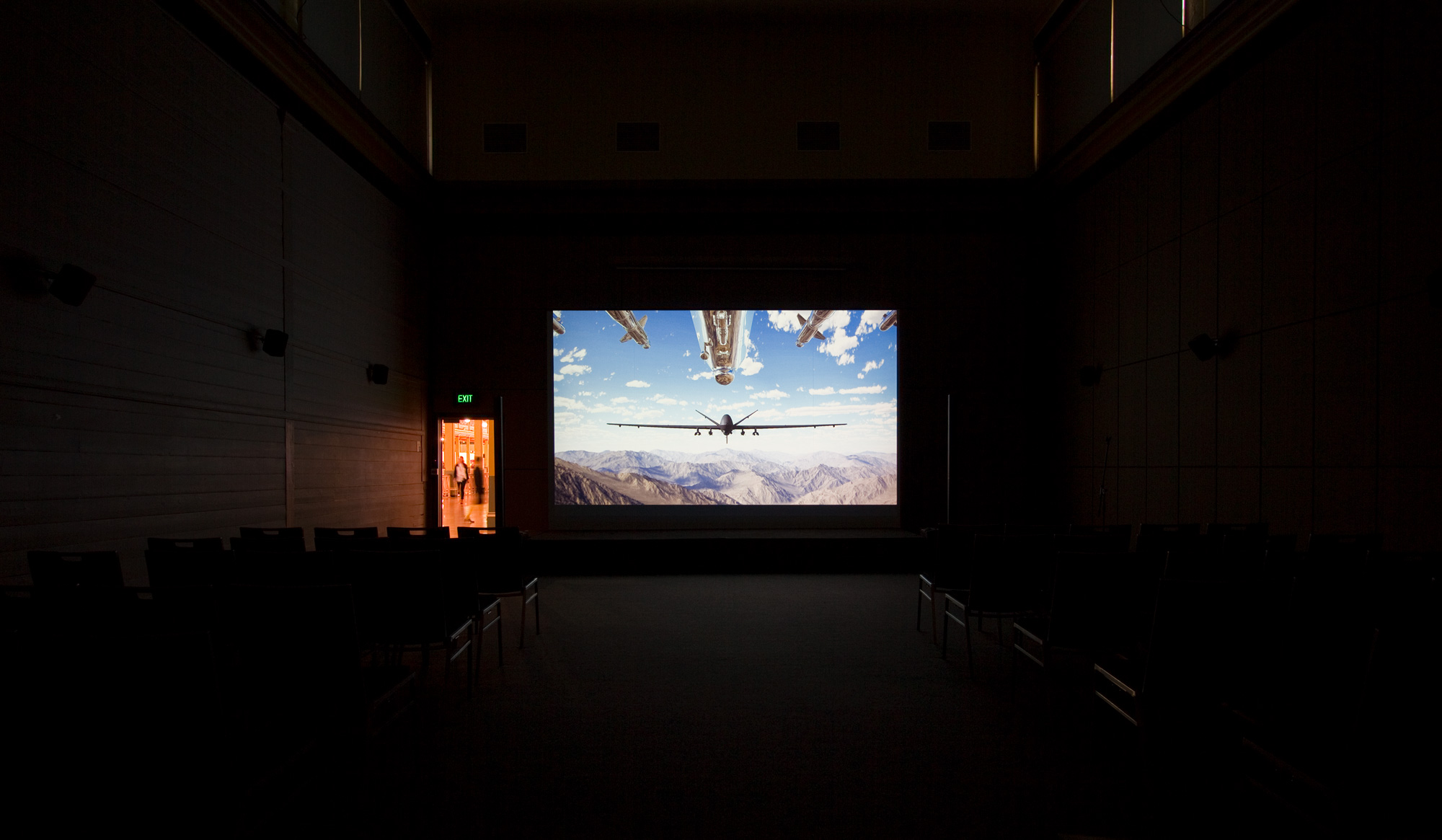
Baden Pailthorpe, MQ-9 Reaper I, 2014. HD 3D animation. Sound. 4 mins 39 sec. Installation View. MAF Video, Synthetic Landscapes, Royal Exhibition Building, Melbourne.
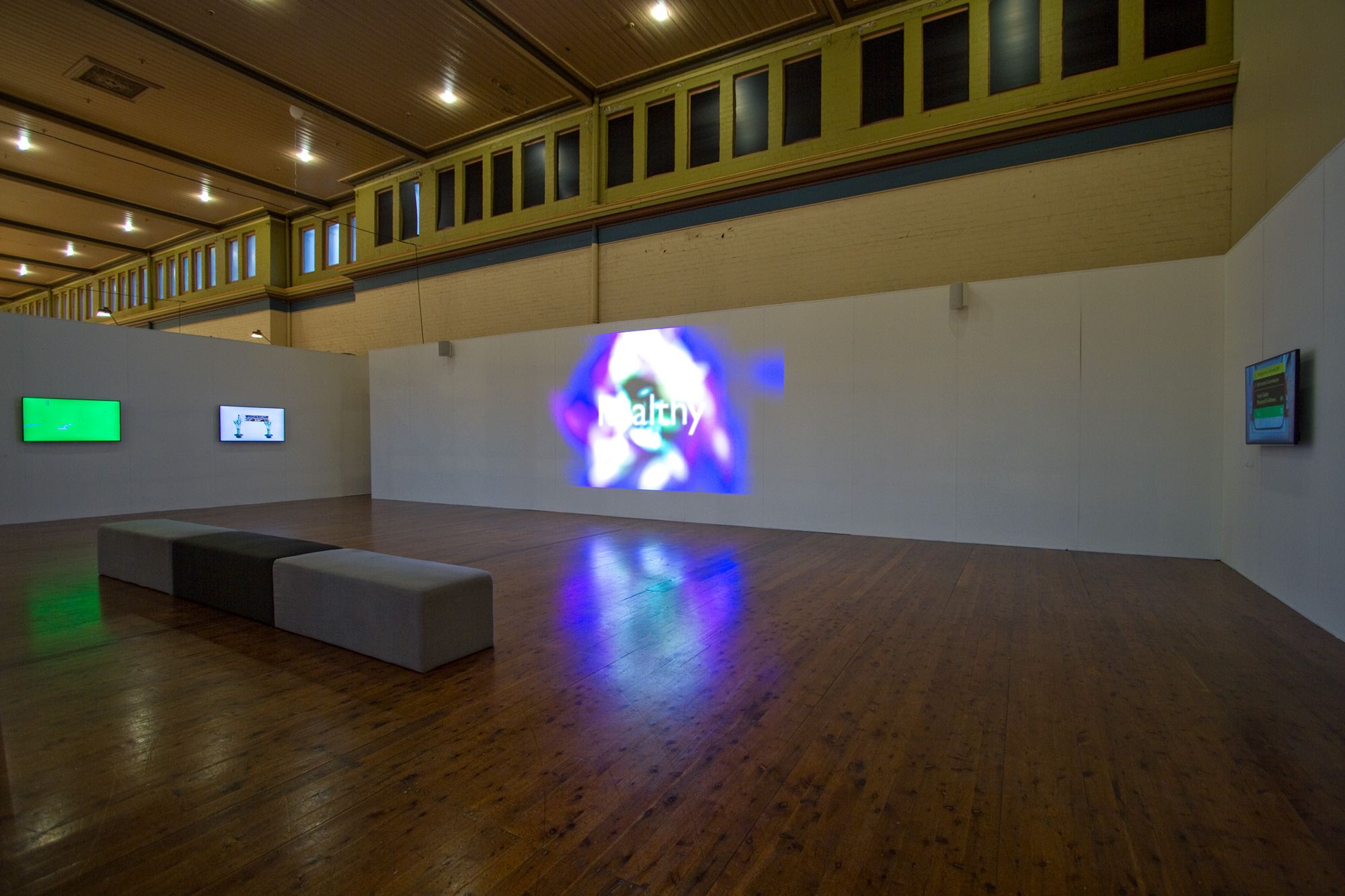
MAF Video, Circuits of Consumption. Installation View. Melbourne Art Fair, Royal Exhibition Building, Melbourne, 2014. Works Visible, left to right: Archie Moore, Kinelexic Tokyo; Hamishi Farah, Self Titled; Grant Stevens, Auric Variations; and Rowan McNaught, Wild Pointer.
